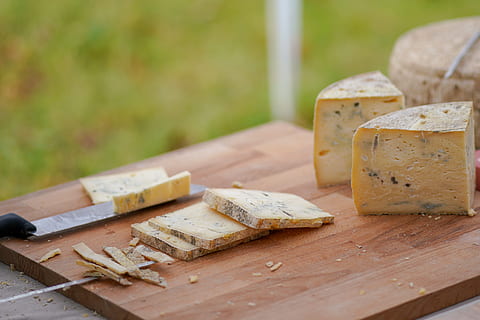你不会因为吃霉菌而死
毫无疑问,霉菌很恶心。打开一个装草莓或一条面包的容器,看到熟悉的蓝灰色的绒毛,你会感到非常害怕。但是如果你吃了一半三明治或一些草莓后才发现霉菌呢?就注定要生病吗?

Mold is a microscopic fungi that is practically ubiquitous in our environments, since it's found indoors and outdoors, and can grow wherever there are high levels of moisture, low light, and above-freezing temperatures — think basements, bathrooms, and refrigerators.
霉菌是一种微生物真菌,实际上在我们的环境中无处不在,因为它在室内和室外都可以发现,并且可以在任何湿度高、光线暗、温度高于冰点的地方生长——比如地下室、浴室和冰箱。
According to The Mold Source, there are over 100,000 types of mold. Thankfully, most of them are harmless to healthy individuals with strong immune systems. Marina Yuabova, D.N.P., a doctor of nursing practice and nurse practitioner in New York City, told Shape, "When the immune system works well, and healthy gut flora is abundant, molds will have no negative impact on the health and wellness of that individual." In other words, most of the time, if you accidentally eat a bit of something moldy, you should just forget about it and move on. As Rudolph Bedford, M.D., a gastroenterologist at Providence Saint John's Health Center in Santa Monica told Women's Health Magazine, "You're not going to die from eating mold."
根据The Mold资料,有超过100000种霉菌。谢天谢地,它们中的大多数对具有强大免疫系统的健康个体无害。纽约市的护理实践医生和执业护士,告诉Shape,“当免疫系统工作良好,健康的肠道菌群丰富,霉菌将不会对个人的健康和福祉产生负面影响。”换句话说,大多数时候,如果你不小心吃了一点发霉的东西,你应该忘记它,继续生活。圣莫尼卡普罗维登斯圣约翰健康中心的胃肠病学家鲁道夫·贝德福德医学博士告诉《女性健康杂志》说:“你不会因为吃霉菌而死。”
For some people though, exposure to mold — whether eaten or otherwise — can cause an allergic reaction or respiratory illness. And while most molds are ultimately harmless, a few, under the right conditions, produce poisonous substances called mycotoxins, which can make you really sick.
然而,对于一些人来说,接触霉菌——不管是吃的还是别的——都会引起过敏反应或呼吸道疾病。虽然大多数霉菌最终是无害的,但在适当的条件下,少数霉菌会产生一种叫做真菌毒素的有毒物质,这会让你真的生病。
But what about moldy blue cheese? And what if you really don't want to chuck that smoked gouda because of the moldy corner section? Well, here's some good news: blue-veined cheeses are actually made with Penicillium mold spores, and are perfectly safe (and even healthy) to eat (via Food & Wine).
但是发霉的蓝奶酪呢?如果你真的不想因为角落发霉而扔掉烟熏奶酪呢?好吧,这里有一些好消息:蓝纹奶酪实际上是由青霉孢子制成的,食用(通过食物和葡萄酒)是完全安全的。
When it comes to the food in our kitchens, the US Department of Agriculture (USDA) has put out some handy guidelines on how to handle mold. For hard cheeses and firm fruits and vegetables (like carrots), cut off at least one inch around and below the moldy area, being careful to keep the knife away from the mold so as not to contaminate the rest of the food.
说到厨房里的食物,美国农业部(USDA)就如何处理霉菌提出了一些方便的指导方针。对于硬的奶酪和硬的水果和蔬菜(如胡萝卜),至少在发霉的地方周围和下面一英寸的地方切掉,小心地让刀远离霉菌,以免污染其他食物。
For soft fruits and vegetables, foods with a high moisture content (like yogurt and jams), and breads, it's safest to just toss the whole thing. That's because mold has 'roots' that can spread deep into soft foods, well below the visibly-moldy surface. Not only that, but bacteria can grow there along with the mold.
对于松软的水果和蔬菜,水分含量高的食物(如酸奶和果酱),以及面包,把它们全部扔掉是最安全的。这是因为霉菌有“根”,可以深入到软性食物中,远低于明显发霉的表面。不仅如此,细菌还可以和霉菌一起在那里生长。
Even though a couple of bites of mold most likely won't make you sick, it's smart to err on the side of caution. "When in doubt, throw it out" isn't just a catch-phrase for recyclers — it's great advice in the kitchen too.
尽管咬几口霉菌很可能不会让你生病,但明智的做法是谨慎行事。“当有疑问时,扔掉它”不仅仅是回收商的一句流行语,也是厨房里的一个很好的建议。
- 频道推荐
- |
- 全站推荐
- 推荐下载
- 网站推荐


















